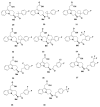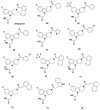Ramatroban-Based Analogues Containing Fluorine Group as Potential 18F-Labeled Positron Emission Tomography (PET) G-Protein Coupled Receptor 44 (GPR44) Tracers
- PMID: 33800801
- PMCID: PMC7961607
- DOI: 10.3390/molecules26051433
Ramatroban-Based Analogues Containing Fluorine Group as Potential 18F-Labeled Positron Emission Tomography (PET) G-Protein Coupled Receptor 44 (GPR44) Tracers
Abstract
Diabetes remains one of the fastest growing chronic diseases and is a leading source of morbidity and accelerated mortality in the world. Loss of beta cell mass (BCM) and decreased sensitivity to insulin underlie diabetes pathogenesis. Yet, the ability to safely and directly assess BCM in individuals with diabetes does not exist. Measures such as blood glucose provide only a crude indirect picture of beta cell health. PET imaging could, in theory, allow for safe, direct, and precise characterization of BCM. However, identification of beta cell-specific radiolabeled tracers remains elusive. G-protein coupled receptor 44 (GPR44) is a transmembrane protein that was characterized in 2012 as highly beta cell-specific within the insulin-positive islets of Langerhans. Accordingly, radiolabeling of existing GPR44 antagonists could be a viable method to accelerate PET tracer development. The present study aims to evaluate and summarize published analogues of the GPR44 antagonist ramatroban to develop 18F-labeled PET tracers for BCM analysis. The 77 corresponding ramatroban analogues containing a fluorine nuclide were characterized for properties including binding affinity, selectivity, and pharmacokinetic and metabolic profile, and 32 compounds with favorable properties were identified. This review illustrates the potential of GPR44 analogues for the development of PET tracers.
Keywords: 18F-labeling; CRTH2; G-protein coupled receptor 44 (GPR44); PET probes; beta cell imaging; beta cell mass (BCM); diabetes; pancreatic islets; positron emission tomography (PET); ramatroban analogues.
Conflict of interest statement
The authors declare no conflict of interest.
Figures

















Similar articles
-
Indole-Based and Cyclopentenylindole-Based Analogues Containing Fluorine Group as Potential 18F-Labeled Positron Emission Tomography (PET) G-Protein Coupled Receptor 44 (GPR44) Tracers.Pharmaceuticals (Basel). 2023 Aug 24;16(9):1203. doi: 10.3390/ph16091203. Pharmaceuticals (Basel). 2023. PMID: 37765011 Free PMC article. Review.
-
[18F]MK-7246 for Positron Emission Tomography Imaging of the Beta-Cell Surface Marker GPR44.Pharmaceutics. 2023 Feb 2;15(2):499. doi: 10.3390/pharmaceutics15020499. Pharmaceutics. 2023. PMID: 36839820 Free PMC article.
-
Synthesis and preclinical evaluation of the CRTH2 antagonist [11C]MK-7246 as a novel PET tracer and potential surrogate marker for pancreatic beta-cell mass.Nucl Med Biol. 2019 Apr;71:1-10. doi: 10.1016/j.nucmedbio.2019.04.002. Epub 2019 Apr 13. Nucl Med Biol. 2019. PMID: 31082767
-
In Vivo Visualization of β-Cells by Targeting of GPR44.Diabetes. 2018 Feb;67(2):182-192. doi: 10.2337/db17-0764. Epub 2017 Dec 5. Diabetes. 2018. PMID: 29208633
-
GPR44 as a Target for Imaging Pancreatic Beta-Cell Mass.Curr Diab Rep. 2019 Jun 27;19(8):49. doi: 10.1007/s11892-019-1164-z. Curr Diab Rep. 2019. PMID: 31250117 Free PMC article. Review.
Cited by
-
One-Step Automatic Radiosynthesis and Evaluation of [18F]TM-30089 as GPR44 Radiotracer.Pharmaceuticals (Basel). 2023 Oct 17;16(10):1480. doi: 10.3390/ph16101480. Pharmaceuticals (Basel). 2023. PMID: 37895951 Free PMC article.
-
Indole-Based and Cyclopentenylindole-Based Analogues Containing Fluorine Group as Potential 18F-Labeled Positron Emission Tomography (PET) G-Protein Coupled Receptor 44 (GPR44) Tracers.Pharmaceuticals (Basel). 2023 Aug 24;16(9):1203. doi: 10.3390/ph16091203. Pharmaceuticals (Basel). 2023. PMID: 37765011 Free PMC article. Review.
References
-
- Krogvold L., Edwin B., Buanes T., Ludvigsson J., Korsgren O., Hyöty H., Frisk G., Hanssen K.F., Dahl-Jørgensen K. Pancreatic biopsy by minimal tail resection in live adult patients at the onset of type 1 diabetes: Experiences from the DiViD study. Diabetologia. 2014;57:841–843. doi: 10.1007/s00125-013-3155-y. - DOI - PubMed
Publication types
MeSH terms
Substances
Grants and funding
LinkOut - more resources
Full Text Sources
Other Literature Sources
Research Materials

